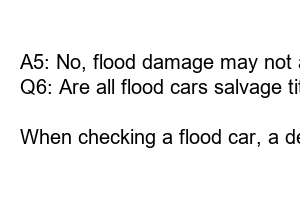침수차 확인하는 방법
Title: How to Check a Flood Car: A Comprehensive Guide
Introduction:
A flood-damaged vehicle can lead to costly repairs and potential safety hazards. Whether you’re considering buying a used car or assessing your current one after a flood, it’s crucial to know how to identify potential flood damage. In this blog post, we will walk you through the essential steps to thoroughly check a flood car.
Subheading 1: Exterior Inspection
Inspecting the car’s exterior is the first step in determining flood damage. Look for **watermarks or moisture lines** on the body, windows, and headlights. Check for signs of **mud or debris accumulation** in hard-to-reach areas and under the wheel arches.
Subheading 2: Interior Inspection
Moving on to the interior, **check for musty odors**, which may indicate water penetration. Feel the carpets and upholstery for dampness or excessive moisture. **Check for water lines or stains** on the seats, in the trunk, and on the door panels.
Subheading 3: Electrical System Evaluation
Flood damage can significantly impact a car’s electrical components. Start by **checking all the electronics** – lights, wipers, radio, air conditioning, etc. Look out for any indications of **erratic behavior or malfunctions**. Additionally, thoroughly inspect the **fuse box for signs of water damage**.
Subheading 4: Engine Inspection
Checking the engine of a potential flood car is crucial. Begin by **removing the oil dipstick** and examining the oil for signs of **milky discoloration**, which could indicate water mixing with the oil. Make sure to examine the **air filter for water stains** as well.
Subheading 5: Test Drive
Taking the car for a test drive is an essential step in assessing its condition after a flood. Pay close attention to any **unusual engine noises**, vibrations, or erratic behavior. Test the brakes, steering, and acceleration thoroughly to ensure everything is in proper working order.
Subheading 6: Seek Professional Help
If you’re unsure about your findings or simply want an expert’s opinion, it’s wise to have a **qualified mechanic or technician** inspect the car. They have the necessary knowledge and specialized equipment to detect any hidden flood damage or potential risks.
Frequently Asked Questions (FAQs):
Q1: Can a car be deemed a flood car even if it did not submerge entirely?
A1: Yes, even partial submersion can cause significant damage due to water infiltration.
Q2: Is flood damage repairable?
A2: Depending on the extent of the damage, repairs may be possible. However, it’s often an expensive and time-consuming process.
Q3: Is it advisable to purchase a flood car if it has been repaired?
A3: It’s generally recommended to avoid buying flood-damaged vehicles, even if they have been repaired. The potential for hidden issues and future problems remains.
Q4: What is the impact of flood damage on a car’s resale value?
A4: A flood-damaged vehicle generally experiences a significant decrease in resale value due to its history and potential future problems.
Q5: Can a clean Carfax report guarantee a car is free of flood damage?
A5: No, flood damage may not always be disclosed on a Carfax report. Thorough inspections are necessary to be certain.
Q6: Are all flood cars salvage titled?
A6: Not all flood cars are given salvage titles, so be cautious and conduct a thorough inspection regardless.
Summary:
When checking a flood car, a detailed examination of the exterior and interior, the electrical system, the engine, and taking it for a test drive are critical steps. It is also advisable to consult a professional mechanic to ensure accurate evaluation. Remember, detecting flood damage early can save you from costly repairs and potential safety hazards in the future.

